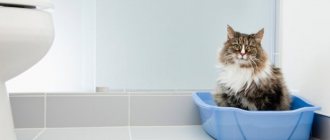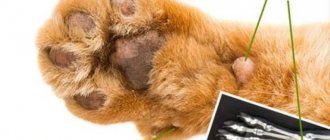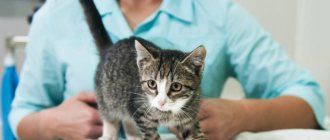Veronica Igorevna Sharipova
veterinarian Petstory
Almost every day, owners contact veterinary clinics with a complaint that their cat often goes to the toilet in small quantities. But not everyone knows that in most cases this problem can be prevented! So, the rest of our article is all about the causes of frequent urination in cats and possible ways to treat it.
How often do cats pee normally?
At home, cats go to the toilet from 1 to 3 times a day, kittens can normally pee more often - up to 4-6 times a day. In outdoor conditions, uncastrated cats can walk much more often - this is how they mark their territory.
The number of trips to the toilet per day depends on the method of feeding (dry food or wet food), the amount of water drunk (some cats willingly drink water from any bowl, and some like only fresh water from the tap), as well as on the individual characteristics of the pet. But, if a cat constantly goes to the toilet, this is a reason to be wary and consult a doctor.
When do kittens pee on their own?
Newborn kittens are helpless. They are born with their eyes closed and ear canals closed, making them virtually blind and deaf during the first few weeks of life.
In fact, very young kittens depend on their mothers for almost everything, and toileting is no exception. When the kitten is very small, the mother cat will lick it to stimulate urination and defecation.
© shutterstock
What should you be wary of if a cat pees often?
So, what symptoms should alert the owner?
- Increased frequency of visits to the litter box. For example, if a cat always went to the litter box once a day, and suddenly began to go 3-4 times or more, this is a reason to go to the clinic, even without other health complaints.
- Presence of blood in the urine. This is a sign of damage to the wall of the bladder and urethra.
- If your pet suddenly starts drinking a lot and peeing a lot. This is a symptom of so-called polyuria and polydipsia, which may indicate a serious illness in the pet (for example, diabetes).
- If your cat constantly runs into the litter box and urinates little by little, this may be a sign of cystitis.
- If a cat sits in a tray for a long time and there is no urine or very little of it, this is quite dangerous. This condition may indicate that the cat has a blockage of the urethra, and it threatens his life. In such a situation, you should immediately contact a veterinarian.
When to sound the alarm
Violation of the process of urination and its frequency after some time is accompanied by other signs of the development of pathological conditions. Therefore, it is important to pay attention to how many times a cat pees, the quality of its urine and the general condition of the animal. Owners should be alarmed by the following signs:
- cloudiness and change in the color of urine (instead of light yellow - orange, brown, the color of meat slop, or, conversely, colorless);
- a swollen or hard, tense abdomen, when stroking the cat reacts painfully or aggressively;
- the pet misses the tray and pees intensely;
- strong thirst appeared for no apparent reason;
- the appetite disappeared, the cat became lethargic or, conversely, restless.
The first sign of the development of many pathologies in cats is just a change in the quantity and quality of fluid secreted, which is why it is so important to monitor how many times a day a cat pees. Felines are one of the hardiest animals, and deterioration in their general condition often manifests itself only against the background of chronic processes.
Causes of frequent urination in cats and kittens
Next, let's take a closer look at the reasons why a cat may pee frequently:
Stress
Oddly enough, frequent urination or cystitis due to emotional experiences is the most common problem detected by a doctor at the initial appointment. In this case, doctors diagnose idiopathic cystitis. As a rule, the disease is typical for young pets. The causes of stress in cats can be very diverse - not only obvious (a car ride, a visit to the veterinarian, a noisy party at the house), but also chronic (boredom, an inconvenient litter box, lack of scratching posts).
Bacterial cystitis
Microflora enters the bladder and, as a result, cystitis develops. This disease is quite rare in cats and usually occurs as a complication after bladder catheterization.
Urolithiasis disease
This is the scourge of modern domestic cats. In a cat, this problem may manifest itself as a frequent urge to urinate. The disease is associated with impaired fluid intake of the animal at home, as well as obesity and lack of activity in the home. When cats drink little and exercise little, they begin to go to the toilet rarely. Accordingly, urine accumulates in the bladder for a long time, salt crystals begin to precipitate, forming stones. With the development of the disease, blockage of the urinary canal or inflammation of the bladder wall, due to abundant salt deposition, the cat begins to urinate frequently.
Mechanical damage to the bladder
After catheterization, it quite often leads to the development of cystitis and, as a consequence, to the fact that the cat often pees.
Presence of a tumor in the bladder
Unfortunately, neoplasms in cats can occur at any age, even at a very young age, and the reasons for their appearance are unknown.
Kidney diseases
Such diseases in the final stages and, as a result, a decrease in the density of urine, lead to the fact that the cat begins to pee a lot. The fact is that secondary absorption of urine ceases to occur in the kidneys, and all the water that the cat drank transits into the bladder. In such conditions, despite drinking plenty of fluids, cats are usually severely dehydrated.
Diabetes
With this disease, the pet begins to drink a lot and, as a result, often runs to the toilet. The disease is typical for overweight older cats who lead a sedentary lifestyle. Therefore, if a cat begins to drink and pee a lot, then it is necessary, first of all, to measure the sugar in his blood.
Hormonal diseases
Hyperthyroidism and hyperadrenocorticism are quite rare pathologies and lead to increased thirst and, as a consequence, increased urination.
How to avoid urinary problems
Every owner of a cat should be aware that if the animal once gets a similar illness, it will be quite difficult to get rid of it. In order for your pet to feel comfortable and lead a full life, it is necessary to take a number of preventive measures and periodically visit the veterinarian. You can prevent possible abnormalities when urinating by following some tips:
- The animal must be vaccinated on time to reduce the risk of developing infectious diseases in the body.
- The pet should not be overcooled.
- The water must be clean and fresh. In addition, the animal must have unlimited access to fluids.
- The diet must exclude prohibited foods and must be compiled according to the rules of nutrition for a cat.
- The animal should move a lot, which is facilitated by outdoor games (at least 30 minutes a day).
If problems with urination occur, the animal should be treated by a veterinarian. Prescribing medications on your own can aggravate your pet’s condition and put its life in danger.
Associated symptoms
Depending on the cause of frequent urination, it may have various accompanying symptoms:
Against a background of stress
, in addition to the fact that the cat often pees, it can hide in closets, under the bed, and refuse food and water.
For bacterial cystitis
The cat usually doesn't feel well. She is lethargic, eats little, and may even vomit.
For urolithiasis
, especially when it is completely difficult to empty the bladder, cats stop eating and drinking. They constantly run into the tray, sometimes even sleep there, regularly strain on the tray and meow pitifully. As a rule, cats also have severe stomach pain, and they do not allow it to be touched.
With mechanical damage to the bladder
After catheterization, a sharp deterioration in the cat’s condition may be observed. There is urination with blood, cystitis, or, conversely, its complete absence. Also, due to the pain factor, the cat may refuse to eat and generally be sad.
Presence of a tumor in the bladder
, as a rule, has no other symptoms other than frequent urination. The condition is characterized by a gradual deterioration.
For kidney diseases
cats begin to lose weight, their coat becomes dull and dirty. Cats often refuse to eat and vomit occasionally. It is also common for cats with kidney disease to have bad breath. Cats become sad, don’t play, and sleep all day.
For diabetes
, in addition to profuse thirst and constant urination, the pet is characterized by significant obesity and the so-called perverted appetite - cats may begin to eat foods that they have never eaten before. But at the same time, with an excessive increase in blood sugar levels, on the contrary, cats may become lethargic and refuse to eat.
In the presence of hormonal diseases
cats can have a variety of symptoms. Often this is a sharp decrease in weight, poor coat quality, and the belly may be enlarged. At the same time, appetite, as a rule, does not disappear, and may even increase.
Diagnostics
As noted above, if a cat pees often, there can be many reasons for this. Therefore, in order not to miss a serious deterioration in the pet’s health and to begin treatment on time, it is necessary to conduct a full diagnosis.
Diagnostics must include:
- Detailed urine analysis.
It looks at the density of urine (kidney function), the amount of protein (inflammation, kidney function), the presence of sugar (diabetes), acidity, sediment, and so on. Each of these indicators can be decisive in making a diagnosis.
- General blood analysis.
It may show the presence of bleeding due to bladder injury, an increase in the number of white blood cells due to infection, etc.
- Blood biochemistry.
It shows blood sugar levels and allows you to evaluate kidney function (creatinine, urea, phosphorus). Elevated liver enzymes may indicate the presence of endocrine diseases.
- Ultrasound of the genitourinary system
. This is the most important diagnostic method that allows you to assess the condition of the bladder, in particular its walls, the presence of stones, salts, and neoplasms. The condition of the kidneys, ureters, and the visible part of the urethra is also necessarily assessed.
But, of course, there are exceptions when drawing up an examination plan. For example, if the pet is young, he has not had any health complaints and there is a suspicion of stress
, in most cases, you can limit yourself to performing an ultrasound of the abdominal cavity.
If bacterial cystitis
, urine must be collected in a sterile manner using cystocentesis (puncture of the abdominal wall) and sent for analysis: bacteriological culture with selection of an antibiotic.
Make an accurate diagnosis of urolithiasis
is possible only by submitting the removed stone for a special analysis to determine its structure.
If you suspect mechanical damage to the bladder
After catheterization, ultrasound may be sufficient. But, to assess the dynamics of recovery, it is necessary to conduct several examinations.
When visualizing a tumor in the bladder
, in addition to a complete examination of the cat to exclude the presence of other neoplasms (in this case, it is best to perform a computed tomography), to take a piece of the tumor for histology analysis, a puncture (biopsy) is required. Only in this case can the nature of the tumor be determined and special treatment prescribed.
If you suspect kidney disease, diabetes mellitus and other hormonal
The disease requires a thorough and comprehensive diagnosis of the pet. Also, in each specific case, the doctor may prescribe additional tests to clarify the diagnosis (for example, blood tests for indicators such as SDMA, cortisol, etc.)
Hurry up, choose a box and find out what gift awaits you
Discount on pet insurance
Promo code copied to clipboard
Treatment
For cystitis due to stress
sedatives are prescribed, such as “express calm” for cats or special diets (royal canin calm). But it is important to understand that treatment will be ineffective if the cause of stress is not eliminated.
Bacterial cystitis
treated with antibiotic therapy. But it should be noted that to make a diagnosis and select a drug, it is necessary to conduct a special study. This is taking a sterile urine sample through a puncture of the abdominal wall and submitting it for bacteriological culture with antibiotic titration (that is, selecting a drug that best copes with the found bacterium). Only in this case is it possible to defeat the infection, prevent its reoccurrence and the development of antibiotic-resistant strains of microorganisms.
Treatment of urolithiasis
completely depends on the nature of the stones that are found in the cat, so analysis is indispensable. For example, if struvite salts (synonym - tripel phosphates) are detected in a urine test, it is sufficient to prescribe a special diet (for example, royal canin urinary) and improve the cat's drinking regime (switching to wet food, purchasing special fountains for cats, from which they drink water more readily, than from a bowl). Other types of salts (for example, oxalates) require an individual approach and a treatment regimen depending on the concomitant diagnoses in the cat (for example, these salts are often found in cats with kidney disease).
Mechanical damage to the bladder
after catheterization requires the development of treatment tactics in each specific case. Pain medication, antibiotics, and even possible surgery may be needed.
If you suspect a tumor in the bladder
First, a histological analysis is taken to determine the type of tumor. Depending on the results, treatment is prescribed - chemotherapy, removal of the tumor or the entire bladder.
In most cases of kidney disease
, unfortunately, are incurable and require only supportive treatment. But, in modern conditions, with timely treatment, it is possible to extend the life of a cat with kidney disease by several years!
Diabetes
in cats, as in people, it requires insulin injections, and necessarily a special diet and weight loss. With timely treatment, constant monitoring of blood sugar levels and individual selection of insulin dosage, in about half of cases, diabetes in cats can be completely cured!
Various hormonal diseases
require constant monitoring of blood tests and selection of the dose of hormonal drugs. In some cases, if the disease is caused by a tumor, surgery to remove it is recommended. Only an endocrinologist can deal with such patients.
What do crystals in cat urine look like?
The crystals in cat urine are microscopic, making them difficult to detect with the naked eye. If you are concerned that your cat has crystals in its kidneys, you should take your pet to the vet. Your veterinarian will perform blood and urine tests to determine the level of crystals in your cat's urine. This test will also provide other results that can help diagnose various health problems.
However, you should keep an eye out for any changes in the color, consistency, or frequency of your cat's urine. If anything is wrong, contact your veterinarian.
Prevention
Unfortunately, not all diseases can be prevented. For the development of a tumor in the bladder
, genetically determined
kidney disease
or
hormonal diseases
cannot be affected.
Bacterial cystitis
usually occurs as a complication of other diseases. But we can follow simple rules to avoid other reasons why a cat may often go to the toilet in small ways:
Firstly, it is very important to prevent the development of stress
in the house, for this you need:
- from a very early age, accustom the kitten to being carried, traveling, visiting guests, and ideally to having other pets in the house (a dog and a cat can be great friends if they have known each other since childhood);
- if there are several cats in the house, each one must have a tray, a separate bowl, several drinking bowls, several houses and scratching posts. Also, every cat should have the opportunity to hide in a safe shelter to be alone;
- Before guests arrive or go to the clinic, if the cat is not accustomed to noise and crowds of people, it is advisable to use sedatives.
Prevention of urolithiasis
is to provide the cat with an active lifestyle and plenty of fluids. It is very important to monitor what your cat drinks from. If she doesn't drink much, it might be worth changing the bowl, buying a special water fountain for cats, etc.
Prevention of diabetes
– this is control over the pet’s excess weight and proper feeding.
Features of kittens
A kitten may need to go to the toilet frequently for a variety of reasons. In very young kittens, the problem may be associated with congenital pathologies such as malformations of the bladder, diverticulum of the ureteral orifice, urethral stricture, urethrorectal fistula, atony or hypertonicity of the sphincters. In older kittens, cystitis can be caused by stress. Also, kittens aged 7–8 months have episodes of urolithiasis.
When do kittens pee in the litter box?
Kittens largely learn to use a litter box when they begin to urinate and defecate on their own, around 3-4 weeks of age. This process is actually quite unusual as it is based on both instinct and observation.
Kittens have a natural instinct to scaveng on the ground or sand. This instinct is very primitive and goes back to the wild ancestors of our kitten, who peed only in those places where they could subsequently actively hide their smell.
Our pet kittens still retain this instinct, and by providing them with a litter box, we give them the perfect place to pee!
Kittens also watch their mothers closely and learn to use the litter box simply by watching. Most cat owners will never need to formally "train" their kitten to use a litter box because by the time they arrive at their new home, they will likely have been doing it for several weeks.
One of the few times kittens won't want to use the litter box is if they are disabled or have arthritis.
Main
- There are many reasons for frequent urination, from cystitis to serious systemic diseases.
- Regardless of age, if a cat pees often and little, this is always a pathology that needs to be understood and treatment selected.
- To make a diagnosis, a comprehensive diagnosis is required. In most cases, this is a urine test, blood tests, and ultrasound of the genitourinary system.
- There is no symptomatic treatment in this situation, since in each specific case it is necessary to look for the cause of the disease and treat it.











